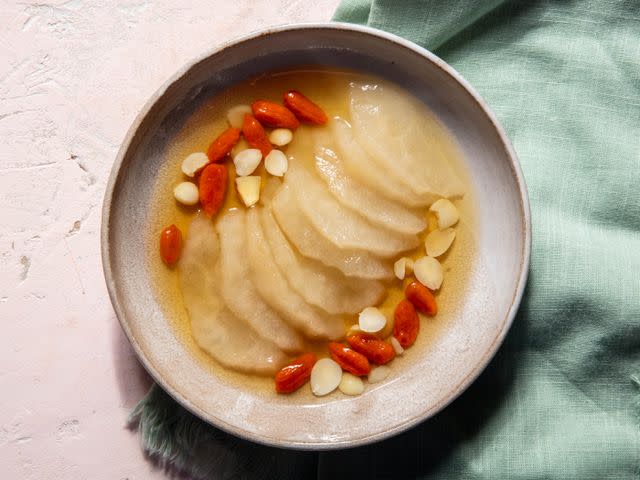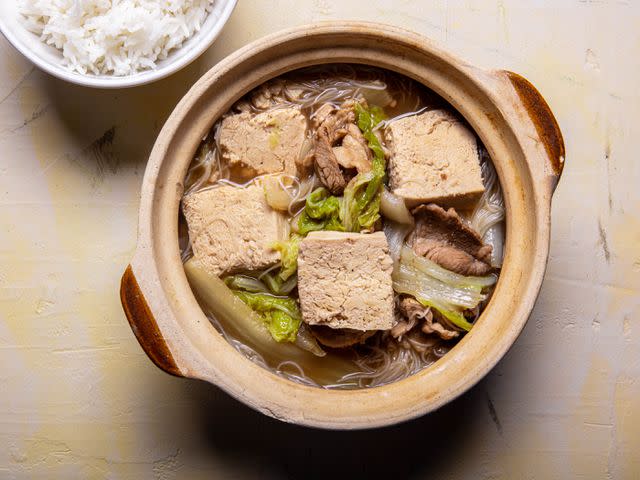Freeze en Place: How to Use Your Freezer as a "Cooking" Tool
Freezing can transform the texture and flavor of a range of different ingredients.

Vicky Wasik
The wonders of the freezer as a tool for preserving food are obvious, but the freezer can do a lot more than just store food. It can also be used as a cooking instrument. Some of these techniques have been written about on Serious Eats before. There's cryo-shucking clams and other shellfish; cryo-blanching vegetables and herbs like basil; tenderizing octopus; and hardening up squishy pork fat to make slicing easier.
However, there are other possibilities. If you were to consult the Chinese home-cooking playbook, you'd find a whole host of techniques that use the freezer to transform the textures of food and enhance flavors in ways that would be difficult to achieve otherwise.
Many of these techniques predate the use of modern freezers. In Northeast China, it was common practice to store fruits, vegetables, and other ingredients outside the home during the winter, exposed to snowy sub-zero temperatures. Some of the ingredients would be kept there throughout the season and then eaten in the warmer months, but others would be cooked and eaten during the cold season. And when those ingredients were brought back indoors and thawed, they'd be markedly different, altered in fundamental ways. To illustrate how the freezing process can change ingredients, and for ideas for how to take advantage of those changes to produce delicious food, let's look at the specific examples below, each of which has an accompanying recipe.
Roasted Frozen Sweet Potatoes

Vicky Wasik
My favorite application of this idea is also one of the simplest. During the winter, in many East Asian cities, including Hong Kong, where I grew up, you’ll find roasted sweet potato vendors parked on street corners. On one end of a small cart is a massive wok filled with pebbles, heated with coal. The vendor continually tosses the pebbles in the wok along with sweet potatoes to produce beautifully caramelized wok-roasted sweet potatoes with bright, fluffy flesh and a thin, papery, toasted skin. In cities with colder climates, the vendors are able to consistently achieve this cloud-like texture by first freezing the whole sweet potatoes before they’re roasted, either by allowing them to naturally freeze on the cart in ambient sub-zero temps or, in at least in a few cases I know of in Hong Kong, by deliberately placing them in a freezer.
As the sweet potato freezes, the water that’s inside the sweet potato forms ice crystals, which have sharp and jagged edges that puncture the cell walls of the flesh, altering the texture of the potato such that when it's roasted, it comes out more tender and fluffy. Based on further testing of this technique by Tim Chin (spoiler: he found this freeze-roast method produces the most delicious bakes sweet potato by far), there's an added benefit to the freezing step. By lowering the potato's starting temperature and then roasting it while still frozen, the potato spends even more time in a very special temperature zone between 135°F to 170°F (57°C to 76°C), the temperature range in which a natural enzyme in the potato called amylase starts working overtime to convert complex starches into sweet maltose sugar. This is something Kenji takes advantage of in his roasted sweet potato and mashed sweet potato recipes as well.
The result is a gorgeously roasted sweet potato with a deep sweetness and a texture reminiscent of sweet potato pie. It's wonderful eaten straight out-of-hand, but I also whipped up a simple but flavorful presentation in which the roasted frozen sweet potato is topped with light and tangy whipped creme fraiche and sprinkled with granola.
I've found that this technique works best on sweeter varieties of sweet potatoes, such as purple-fleshed sweet potatoes or Carolina ruby yams, where the naturally high moisture content exaggerates the effect of the freezing. On the flip side, roasting frozen white-fleshed Okinawan sweet potatoes (and regular Russet potatoes) isn't as effective.
Get Recipe:Roasted Frozen Sweet Potatoes With Whipped Crème Fraîche and Granola
Ice-Poached ("Cryo-Macerated") Fruits

Vicky Wasik
The cuisine of Northeast China is deeply rooted in local agricultural practices, one of which is freezing fruits in the winter. One example of this are the Asian pears that are frozen and thawed repeatedly until the once-beige skins turn black and the interiors soften and burst with the juices.
The traditional way of eating the pear is to puncture the skin of the fruit with your teeth and suck up the natural syrup, after which you can eat the fruit in larger bites. The freezing and thawing process transforms the pear, picked when it's hard and sour, into a delight on its own. It still retains its raw pear flavor and tastes almost impossibly fresh, but its texture is soft, with a slight crispness, as if it had been expertly poached.
What happens within the pear is similar to what happens within the sweet potato, but of course the pears aren't subsequently cooked. However, the repeated freezing and thawing causes large, slow-forming ice crystals to break apart the cell walls in the fruit flesh, releasing flavor compounds and sugars. The process also damages the skin, causing it to oxidize (and thus blacken), but the skin remains intact, and I've found that it naturally protects the fruit flesh from freezer burn, making it possible to leave the pears in the freezer for several months with no ill effects. To borrow a term from wine making that describes freezing grapes before fermentation to weaken the skins and extract more tannin and flavor, the pear is effectively “cryo-macerated.”
The technique use for cryo-macerated or ice-poached pears is used for other fruits in Northeast China. Persimmons, peaches, and cherries are all subjected to a similar process to create snacks that are now eaten year around. And the technique has wide applications, such as in my more composed recipe for the ice-poached pears: it's a take on “poached” pears served with a light syrup, in this case flavored with Chinese medicinal ingredients like goji berries, apricot kernels, and osmanthus.
To expand on this idea outside of traditional Chinese cuisine, one can imagine freezing fruits like apples, plums, and apricots to jumpstart the process of extracting sweetness and flavor from them as well, without having to cook them down, for raw jams, jellies, cobblers, or desserts.
Get Recipe:Cryo-Poached Asian Pears With Goji Syrup
Ultra-Absorbent Frozen Tofu

Vicky Wasik
In a savory context, frozen tofu is a popular example of altering the texture of an ingredient by freezing it. Frozen tofu takes on a yellow hue and a more porous texture, which not only gives the tofu chewiness and a meat-like bounce, but also a sponge-like quality that allows it to absorb liquids and deliver more flavor in every bite. The effect is achieved, once again, with the help of ice crystals, which expand as they form, tearing apart the tofu's coagulated protein structure. When the tofu thaws, the water drains out through this web of lacerations, leaving tiny pockets of air throughout.
To enhance this effect, it's best to gently squeeze the thawed tofu between your hands, expressing even more water and increasing the tofu's absorptive potential while concentrating the flavor of the tofu itself.
Frozen tofu is eaten most often in hot pots, braises, soups, and saucy dishes where the spongy texture can soak up the cooking liquid. Even in the simplest of liquids, as in my recipe for frozen tofu simmered with Napa cabbage, pork, and a little ginger and garlic, the tofu becomes juicy and substantial in a way that fresh tofu simply won't.
Get Recipe:Simmered Frozen Tofu Soup With Pork and Cabbage
Other Applications
These are just a few examples of how freezers can be used to manipulate both the texture and flavor of foods. When considering how else to use the freezer in similar ways, it's helpful to keep in mind two (related) effects freezing has on ingredients—softening and moisture loss—to determine whether using the freezer might be a good idea.
When considering softening, ask yourself whether there's likely to be any benefit to achieving a looser, more tender, and potentially spongier texture. Root vegetables like beets and taro, for example, might benefit from the softening effects of the freezer, as that’s the ultimate texture we usually look for. But leafy greens, cabbage, or Brussels sprouts, on the other hand, would become limp and unappealing for a stir-fry in which you want the vegetables to retain a bit of crispness.
As for moisture loss, it's an inevitable effect when freezing most ingredients, thanks to all that cellular damage from the ice crystals. While it works wonders with sweet potatoes, pears, tofu, and more, it can be a problem with ingredients like meats, where you want to retain as much moisture as possible. If in doubt, though, remember that there's little harm in experimentation. You may just stumble upon an entirely new way to prepare and enjoy one of your favorite foods.

